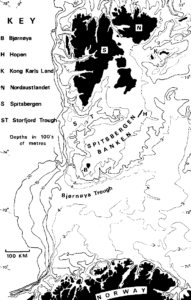Svalbard Publication Resources
This page contains publications that emphasize Svalbard. Most major articles are accompanied by the abstract and a few key figures.
Late Precambrian glacial loessites of north Norway and Svalbard SEPM 1979 ABSTRACT Faintly stratified siltstones intercalated with late Precambrian tillites and glaciolacustrine and glaciomarine mudstones are interpreted to be indurated wind deposited silts, or “loessites.” In thin section, the siltstones are distinguished by their high silt and low clay content, comparatively good sorting, and abundance of angular particles. Samples show a preferred grain orientation both parallel and perpendicular to bedding, and together with previous observations on Quaternary loessites, support the use of grain orientation in determining paleowind direction and sediment source area. CLOSE ALL Sandstone in Lower Cretaceous Helvetiafjellet Formation, Svalbard: reservoir potential of Barents Shelf AAPG 1979 Abstract The Helvetiafjellet Formation consists of 50 to 100 m of largely fluvial sandstones and shales deposited throughout Svalbard during a major regression. Sandstones consist chiefly of monocrystalline and polycrystalline quartz, feldspar, chert, and volcanic (basaltic) rock fragments in (1) quartz and quartzose arenites, (2) quartzose lithic arenites, and (3) volcanic arenites. Quartz and quartzose arenites dominate in western Spitsbergen and were derived from a mixed sedimentary-metamorphic terrane in the west. Volcanic arenites are present in Kong Karls Land in the east, and are intercalated with basaltic lava flows which are considered to be the major source for the sandstones. Quartzose lithic arenites in southeast Spitsbergen are a mixture of quartz sands derived from the west and reworked volcanic sands transported from the east. Cementing minerals are variably developed in these sandstones. Quartz overgrowths are dominant in quartz and quartzose arenites. Kaolinite is present in many feldspar-bearing quartz and quartzose arenites, whereas illite is rare. Chlorite is common, together with calcite, in quartzose lithic arenites. Abundant smectite and calcite with minor zeolites are present in the volcanic arenites, which suggests a strong relation between mineralogy of the detrital grains and that of associated cements. Unstable detrital grains released ions to pore waters, which subsequently precipitated clay and calcite cements. Induration increases and maximum porosity decreases from east to west across Svalbard, owing both to higher temperature, caused by progressively greater burial depth and steeper geothermal gradients, and to tectonic stress in westernmost areas. Early Cretaceous volcanic activity may have provided abundant chemically unstable detritus to basins in the southern part of the Barents Shelf. As a major consequence, clay cements could form during diagenesis, adversely affecting sandstone reservoir parameters. However, the development of secondary dissolution porosity could improve reservoir characteristics of those sandstones which contain chemically unstable minerals such as feldspar grains and calcite cement. CLOSE ALL Composition, provenance and diagenesis of sandstones in Lower Cretaceous Helvetiafjellet Fm, Svalbard IKU 1978 ABSTRACT The Helvetiafjellet Formation consists of 50 – 100 m of largely fluvial sandstones and shales deposited throughout Svalbard during the Lower Cretaceous regression. Sandstones contain five major detrital components: monocrystalline and polycrystalline quartz, feldspar, chert and volcanic (chiefly basaltic) rock fragments. These form three main sandstone types: 1) quartz and quartzose arenites, 2) quartzose lithic arenites, and 3) volcanic arenites. Type (1) occurs in many part of Spitsbergen and was derived from a mixed sedimentary-metamorphic terrain to the west. Type (3) occurs in Kong Karls Land in the east, and is intercalated with basaltic lava flows which are considered to be the major source for the sands. Intercalated with the volcanic arenites are more quartzose arenites which were derived locally from unconsolidated sands in the Rhaeto-Liassic Wilhelmoya Formation. Type (2) occurs around Kvalvagen, southeast Spitsbergen, and represents a mixture of quartz sands from the west and reworked volcanic sands from the east. Authigenic cementing minerals (identified in thin section, and by XRD and SEM) are abundant in these sandstones. Quartz overgrowths are dominant in the quartz and quartzose arenites, and decrease with decreasing detrital quartz content. Kaolinite is observed in many feldspar-bearing quartz and quartzose arenites, while illite is only seldom observed. Chlorite is common, along with calcite, in quartzose lithic arenites. Abundant smectite and calcite with minor zeolites are present in the volcanic arenites. This suggests a strong relationship between detrital grain mineralogy and the mineralogy of associated cement. Unstable detrital grains released cations to pore waters, allowing abundant clay and calcite cements to form. From west to east, induration decreases and maximum porosity increases, apparently related to reduced depth of burial in the east and influence of Tertiary tectonism in the west. Early Cretaceous volcanic activity may have provided abundant unstable detritus to other parts of the Barents Shelf thereby enabling clay and calcite cements to form during diagenesis, and adversely affecting sandstone reservoir potential. CLOSE ALL Composition, provenance and diagenesis of sandstones in Lower Cretaceous Helvetiafjellet Fm, Svalbard IKU 1978 TEXT The Continental Shelf Institute’s expedition to Svalbard (Spitzbergen) in 1976 investigated the Mesozoic succession of the eastern part of the Svalbard Archipelago. Two dinosaur footprints were discovered by R. Edwards in the course of sedimentological studies of the Lower Cretaceous Helvetiafjellet Formation in southern Heer Land on the island of Spitsbergen (Text-fig. 1). The footprints occur in a large block of sandstone, slightly moved from its original position in thebedrock, on a small promontory west of Boltodden, Kvalvagen. The lower part of the Helvetiafjellet Formation is well exposed on the coast around Boltodden. The cliff face along the east side of Kvalhovden displays large synsedimentary deformation structures associated with the deposition of the Helvetiafjellet Formation sandstones above Janusfiellet Formation shales. For this reason it is not possible to precisely locate the footprint-bearing sandstone bed in a detailed measured section. In this area the sediments of the Helvetiafjellet Formation were deposited on an alluvial plain traversed by meandering rivers. Laterally continuous sandstones represent deposition on broad, gently inclined point bars, whereas shales, often with plant fragments, represent interchannel floodplain deposits. The footprints were apparently made on an emergent point bar during low water, and were probably filled and preserved either by wind blown sand, or by sand deposited during the ensuing flood stage. Both prints are similar in appearance, but differ slightly in size and preservation (Text-fig. 2). The prints show three digits, each with a terminal claw. The side digits make an angle of 35-45 degrees from the central digit. The prints are respectively 28.5 and 29.6 cm long, and 22.5 and 23 cm wide between the tips of the side claws. The heel area forms a depression approximately 3 cm deeper than the surrounding rock surface. These prints were apparently made by a large carnosaurian dinosaur. The only previous record of land reptiles from the Lower Cretaceous of Svalbard is that of Iguanodon footprints at Festningen, 120 km to the northwest, also in the lower part of the Helvetiafjellet Formation (Lapparent, 1962). The occurrence of predatory dinosaurs in Svalbard indicates a more diverse terrestrial reptile fauna than previously known, and suggests that there was a sufficiently large and stable population of herbivores to support carnivorous dinosaurs over an extensive land area. CLOSE ALL The Upper Paleozoic succession of Bjornoya NPI 1976 Abstract CLOSE ALL Sedimentology of late Precambrian Sveanor and Kapp Sparre Formations at Aldousbreen Nordaustlandet NPI 1976 The overlying Kapp Sparre Formation (50+ m) begins with 5 m of fine-grained dolomite, which passes up into a shale unit with edgewise dolomite conglomerate beds in the lower part and turbidite sandstones above. The dolomite is interpreted as a transgressive deposit, while the sandstones reflect isostatic uplift of the surrounding land areas. The sequence is similar to the correlative Polarisbreen Tillite in Ny Friesland, and compares closely with the Smalfjord Formation (lower tillite) and lower part of the Nyborg Formation of Finnmark, North Norway. CLOSE ALL Microplankton from the Janusfjellet Subgroup (Jurassic-Lower Cretaceous) at Agardhfjellet Spitsbergen NPI 1976 Abstract Microplankton are recorded for the first time in the type section of the Janusfjellet Sub-group at Agardhfjellet, eastern Spitsbergen. Assemblages are of Upper Jurassic-Lower Cretaceous age, in agreement with previous datings based on megafauna. An abrupt change in color of organic matter, and improvement in preservation in palynomorphs in a clay-rich interval just above the base of the Lower Cretaceous Rurikfjellet Formation suggest a break in thermal metamorphism. The thermal metamorphism apparently occurred prior to the deposition of the overlying portion of the Rurikfjellet Formation, probably in association with contemporaneous structural and/or intrusive activity. CLOSE ALL Growth faults in Upper Triassic deltaic sediments Svalbard AAPG 1976 Click here to download a PDF reprint of this article (3.6 mb) Abstract Growth faults, rollovers, and shale anticlines affecting Upper Triassic deltaic coarsening-upward sequences are excellently exposed in coastal cliffs on Edgeoya in southeast Svalbard. Study of photographs of the cliffs shows fault configuration, reservoir variations, and internal features of shale anticlines. On downthrown blocks the strata were tilted and rollovers were formed. Beneath the concave-upward growth faults shale anticlines developed and relative uplift of the upthrown block resulted in erosion of some of the newly deposited sands. Subsequent shale deposition formed a local angular unconformity. The faulting may have been initiated by a combination of (1) denser sands overlying less dense clays with excess pore-fluid pressure, (2) a southward prodelta slope and/or regional paleoslope, (3) differential loading associated with deltaic progradation, and (4) a triggering mechanism such as earthquakes. These structures serve as a model for the larger Gulf Coast and Nigerian structures and provide criteria for the recognition of growth faulting in other exposures of ancient deltaic sediments CLOSE ALL A Rb-Sr age for granite-gneiss clasts from the late Precambrian Sveanor Formation, central Nordaustlandet NPI 1976 Abstract Red granite-gneiss clasts occurring in a tillite unit of the late Precambrian Sveanor Formation yield a Rb-Sr whole-rock three point isochron age of l275+-45 m.y. with an initial 87Sr/86Sr ratio of .72l72+-.00056. The high initial 87Sr/86Sr ratio implies derivation of the granite-gneisses from still older crustal rocks. CLOSE ALL Depositional environments in Lower Cretaceous regressive sediments Kikutodden Sorkapp Land, Svalbard NPI 1975 Abstract The relative thinness or absence of corresponding shallow marine deposits between the quiet marine shales of the Rurikfjellet Formation and the continental Helvetiafjellet Formation elsewhere in Spitsbergen may be due to differing subsidence rates, mud accumulation on the delta, or to erosion during the regression. The similarity of these sandstones, in environment of deposition and stratigraphic relationships, to petroleum-producing sandstones in other areas suggests their potential as reservoir rocks where the effects of the Tertiary orogeny were moderate. CLOSE ALL Gravel fraction on the Spitsbergen Bank, northwest Barents Shelf NGU 1975 Abstract The gravel fraction of the bottom sediment on the Spitsbergen Bank, located south of Svalbard in the NW Barents Sea, is composed predominantly of elastic sedimentary rocks, especially sandstone and shale. Between sampling stations the proportion of eight lithologic types is markedly different, ruling out the possibility of large-scale transport of the gravel by ice-rafting. Striated pebbles occur in small numbers: a few are exotic in composition, hut most are similar to a non-striated rock-type at a given station. This suggests that the gravel was formed by reworking of previously deposited glacial material, which tends to be locally derived. The sandstone pebbles in the gravel include a variety of petrographic types, most of which are identical or similar to sandstones of known stratigraphic position on Svalbard. Observations on Mesozoic rocks on Bjornoya, Hopen and southern Spitsbergen, and on the distribution of pebbles as described herein, suggest that the Spitsbergen Bank is underlain by nearly flat-lying Mesozoic sedimentary rocks similar to those known on Svalbard. The overall structure is a gentle syncline; a southward continuation of the dominant regional structure of Spitsbergen. CLOSE ALL Preliminary report on Upper Paleozoic and Mesozoic sandstones of Svalbard: a reconnaissance IKU 1975 ABSTRACT Detailed petrographic investigation of 31 (and casual investigation of more than 100) thin-sections of sandstone samples ranging in age from Upper Devonian to Lower Cretaceous (Albian) of Svalbard shows that there is strong vertical stratigraphic control of sandstone composition, and possibly of grain size and cementation to a minor extent. Feldspars are typically abundant in Mesozoic rocks, while they occur only in one restricted horizon in the Upper Paleozoic. Accessory minerals are limited essentially to tourmaline and zircon in Upper Paleozoic rocks while the assemblage is more varied in the Mesozoic. Further detailed subdivisions are described. Petrographic trends may largely be a response to denudation in the source area(s) during the period of sedimentation; more deeply lying crystalline rocks were progressively exposed to transportation. The results suggest that loose, bottom material from the Barents Shelf may be stratigraphically positioned by thin-section analysis. Thus, material collected during recent dredging can be tested for relative distance of transport by determining the petrographic homogeneity between and within samples from various stations. CLOSE ALL Visitors should also be aware of the Search and Discovery web site , and AAPG members should be aware of the online access to all Bulletins.Edwards 1979: Late Precambrian glacial loessites of north Norway and Svalbard. J. Sedim. Petrol. 49, 85-92.
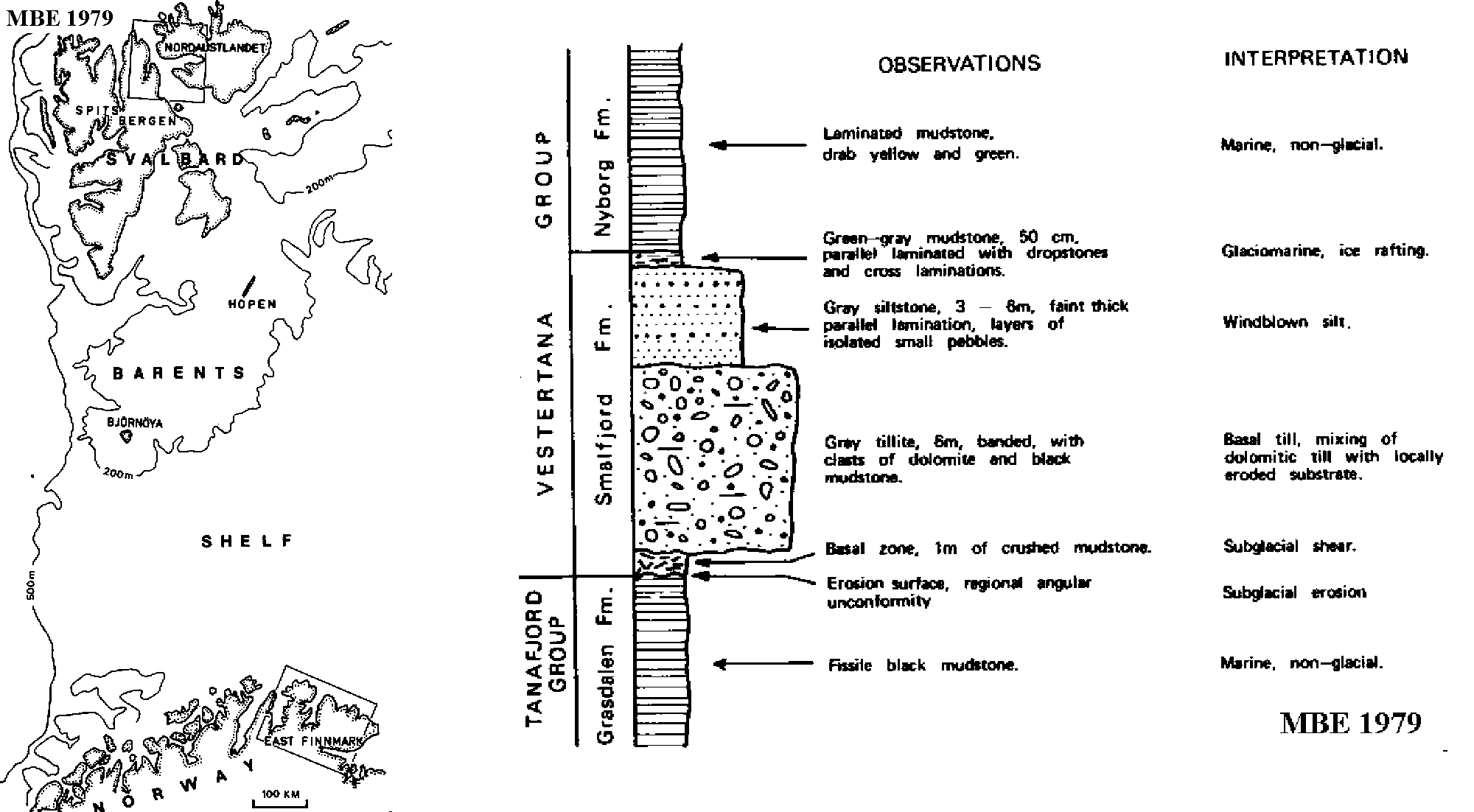
Edwards 1979: Sandstone in Lower Cretaceous Helvetiafjellet Formation, Svalbard: bearing on reservoir potential of Barents Shelf. Amer. Assoc. Petrol. Geol. Bull. 63, 2193-2203.

Edwards 1978: Composition, provenance and diagenesis of sandstones in the Lower Cretaceous Helvetiafjellet Formation, Svalbard. Continental Shelf Institute, Trondheim, Publ. 98, p. 29.
Edwards, Edwards, P.R. and Colbert, E.H. 1978: Carnosaurian footprints in the Lower Cretaceous of Eastern Spitsbergen. J. Paleontology 52, 940-941.
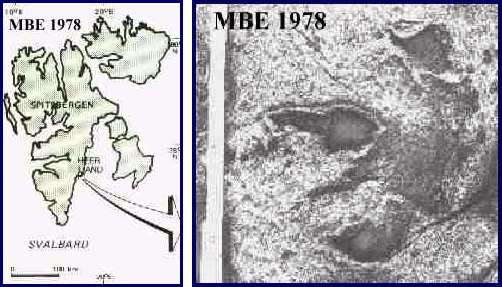
Worsley, D. and Edwards, 1976: The Upper Paleozoic succession of Bjornoya. Norsk Polarinst. Arbok 1974, 17-34.
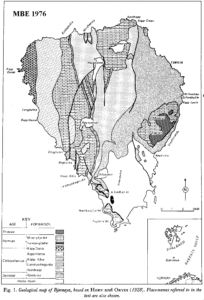
The Upper Palaeozoic succession on Bjornoya comprises eight formations with a maximum composite thickness of about 1300 metres. It rests unconformably on Hecla Hoek basement, and is overlain disconformably by Triassic shales. The lower formations, of Upper Devonian and Lower Carboniferous age, consist of sandstones and shales with subordinate conglomerates and coals, and were deposited in various alluvial environments. The overlying Upper Carboniferous and Permian formations Consist largely of carbonates, with additional sandstones, shales, and cherts; these were deposited in shallow marine and coastal environments. Variations in facies and thickness together with palaeocurrent patterns suggest that Bjornoya lay near the southern margin of a depositional basin during much of the Upper Palaeozoic.Edwards 1976: Sedimentology of late Precambrian Sveanor and Kapp Sparre Formations at Aldousbreen, Wahlenbergfjorden, Nordaustlandet. Norsk Polarinst. Arbok 1974, 17-34.
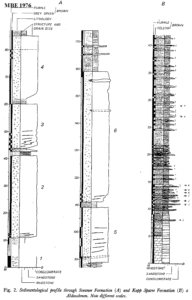 Abstract
Abstract
The easternmost known exposures of the late Precambrian Sveanor and Kapp Sparre Formations occur north of Wahlenbergfjorden, Svalbard. The Sveanor Formation (174 m) here consists of six massive tillite units, each deposited as a subglacial till, and intercalated with six mudstone units. Four mudstone units have muddy laminae and are interpreted as subaqueous deposits, partly with dropstones indicating ice rafting. Two mudstone units lack any substantial clay fraction, are poorly to non-laminated, and consist of well-sorted angular silt particles. These are interpreted as ancient glacial wind-blown loesses.
Bjaerke, T., Edwards, and Thusu, B. 1976: Microplankton from the Janusfjellet Subgroup (Jurassic-Lower Cretaceous) at Agardhfjellet, Spitsbergen–a preliminary report. Norsk Polarinst. Arbok 1974, 63-68.
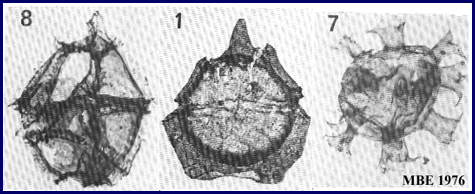
Edwards 1976: Growth faults in Upper Triassic deltaic sediments, Svalbard. Amer. Assoc. Petrol. Geol. Bull. 60, 341-355.

Edwards and Taylor, P.N. 1976: A Rb-Sr age for granite-gneiss clasts from the late Precambrian Sveanor Formation, central Nordaustlandet. Norsk Polarinst. Arbok 1974, 255-258.
Edwards 1975: Depositional environments in Lower Cretaceous regressive sediments, Kikutodden, Sorkapp Land, Svalbard. Norsk Polarinst. Arbok 1974, 35-50.
The change from deposition of marine shales in the Rurikfjellet Formation to variegated continental sediments in the Helvetiafjellet Formation represents a major regression seen in the Lower Cretaceous throughout Svalbard. At Kikutodden, on the south coast of Sorkapp Land, the marine unit includes in its upper part regressive coarsening~up sequences, while the continental unit consists of erosively-based fining-up sequences formed by channel migration on an alluvial plain.Edwards 1975: Gravel fraction on the Spitsbergen Bank, northwest Barents Shelf. In: Petroleum Geology and Geology of the North Sea and Northeast Atlantic Continental Margin (Eds. A. Whiteman, D. Roberts & M.A Sellevoll). Norges geol. Unders. 316, 205-217.
Edwards 1975: Preliminary report on Upper Paleozoic and Mesozoic sandstones of Svalbard: a reconnaissance. Continental Shelf Institute, Trondheim, Publ. 87, p. 31.
